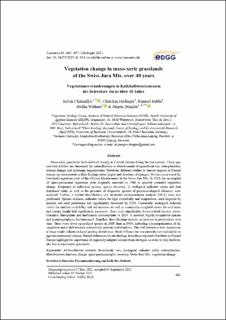Please use this identifier to cite or link to this item:
https://doi.org/10.21256/zhaw-23430Full metadata record
| DC Field | Value | Language |
|---|---|---|
| dc.contributor.author | Charmillot, Kévin | - |
| dc.contributor.author | Hedinger, Christian | - |
| dc.contributor.author | Babbi, Manuel | - |
| dc.contributor.author | Widmer, Stefan | - |
| dc.contributor.author | Dengler, Jürgen | - |
| dc.date.accessioned | 2021-11-10T08:04:45Z | - |
| dc.date.available | 2021-11-10T08:04:45Z | - |
| dc.date.issued | 2021-10-31 | - |
| dc.identifier.issn | 0722-494X | de_CH |
| dc.identifier.issn | 0373-7632 | de_CH |
| dc.identifier.uri | https://digitalcollection.zhaw.ch/handle/11475/23430 | - |
| dc.description.abstract | Meso-xeric grasslands have declined sharply in Central Europe during the last century. These spe-cies-rich habitats are threatened by intensification or abandonment of agricultural use, eutrophication, climate change and landscape fragmentation. However, different studies in various regions of Central Europe are inconsistent in their findings about degree and direction of changes. We thus resurveyed the historical vegetation plots of the alliance Mesobromionin the Swiss Jura Mts. In 2020, we re-sampled 28 quasi-permanent vegetation plots originally recorded in 1980 to quantify potential vegetation change. Frequency of individual species, species diversity, 11 ecological indicator values and four functional traits, as well as the presence of diagnostic species of phytosociological alliances, were analysed. Further, a habitat classification and detrended correspondence analysis (DCA) were also performed. Species richness, indicator values for light availability and temperature, seed dispersal by animals and seed persistence had significantly decreased by 2020. Conversely, ecological indicator values for nutrient availability and soil moisture as well as community-weighted means for seed mass and canopy height had significantly increased. There were significantly fewer ruderal species, stress-tolerators, therophytes and herbaceous chamaephytes in 2020. In contrast, highly competitive species and hemicryptophytes had increased. Together, these findings indicate an increase in productivity over time. There were fewer specialized species in 2020 than in 1980, indicating a homogenization of the vegetation and a shift towards nutrient-rich pastures and meadows. The shift towards a later succession-al stage might indicate reduced grazing disturbance. Most of these sites are currently not included in an agri-environmental scheme. Partial differences of our findings from those reported elsewhere in Central Europe highlight the importance of regionally adapted conservation strategies in order to stop biodiver-sity loss in meso-xeric grasslands. | de_CH |
| dc.language.iso | en | de_CH |
| dc.publisher | Floristisch-Soziologische Arbeitsgemeinschaft | de_CH |
| dc.relation.ispartof | Tuexenia | de_CH |
| dc.rights | Licence according to publishing contract | de_CH |
| dc.subject.ddc | 333.7: Landflächen, Naturerholungsgebiete | de_CH |
| dc.subject.ddc | 580: Pflanzen (Botanik) | de_CH |
| dc.title | Vegetation change in meso-xeric grasslands of the Swiss Jura Mts. over 40 years | de_CH |
| dc.type | Beitrag in wissenschaftlicher Zeitschrift | de_CH |
| dcterms.type | Text | de_CH |
| zhaw.departement | Life Sciences und Facility Management | de_CH |
| zhaw.organisationalunit | Institut für Umwelt und Natürliche Ressourcen (IUNR) | de_CH |
| dc.identifier.doi | 10.14471/2021.41.019 | de_CH |
| dc.identifier.doi | 10.21256/zhaw-23430 | - |
| zhaw.funding.eu | No | de_CH |
| zhaw.originated.zhaw | Yes | de_CH |
| zhaw.pages.end | 457 | de_CH |
| zhaw.pages.start | 441 | de_CH |
| zhaw.publication.status | publishedVersion | de_CH |
| zhaw.volume | 41 | de_CH |
| zhaw.publication.review | Peer review (Publikation) | de_CH |
| zhaw.webfeed | Vegetationsökologie | de_CH |
| zhaw.author.additional | No | de_CH |
| zhaw.display.portrait | Yes | de_CH |
| Appears in collections: | Publikationen Life Sciences und Facility Management | |
Files in This Item:
| File | Description | Size | Format | |
|---|---|---|---|---|
| 2021_Charmillot_Vegetation_change_in_meso-xeric_grasslands_Tuexenia.pdf | 6.39 MB | Adobe PDF |  View/Open |
Show simple item record
Charmillot, K., Hedinger, C., Babbi, M., Widmer, S., & Dengler, J. (2021). Vegetation change in meso-xeric grasslands of the Swiss Jura Mts. over 40 years. Tuexenia, 41, 441–457. https://doi.org/10.14471/2021.41.019
Charmillot, K. et al. (2021) ‘Vegetation change in meso-xeric grasslands of the Swiss Jura Mts. over 40 years’, Tuexenia, 41, pp. 441–457. Available at: https://doi.org/10.14471/2021.41.019.
K. Charmillot, C. Hedinger, M. Babbi, S. Widmer, and J. Dengler, “Vegetation change in meso-xeric grasslands of the Swiss Jura Mts. over 40 years,” Tuexenia, vol. 41, pp. 441–457, Oct. 2021, doi: 10.14471/2021.41.019.
CHARMILLOT, Kévin, Christian HEDINGER, Manuel BABBI, Stefan WIDMER und Jürgen DENGLER, 2021. Vegetation change in meso-xeric grasslands of the Swiss Jura Mts. over 40 years. Tuexenia. 31 Oktober 2021. Bd. 41, S. 441–457. DOI 10.14471/2021.41.019
Charmillot, Kévin, Christian Hedinger, Manuel Babbi, Stefan Widmer, and Jürgen Dengler. 2021. “Vegetation Change in Meso-Xeric Grasslands of the Swiss Jura Mts. Over 40 Years.” Tuexenia 41 (October): 441–57. https://doi.org/10.14471/2021.41.019.
Charmillot, Kévin, et al. “Vegetation Change in Meso-Xeric Grasslands of the Swiss Jura Mts. Over 40 Years.” Tuexenia, vol. 41, Oct. 2021, pp. 441–57, https://doi.org/10.14471/2021.41.019.
Items in DSpace are protected by copyright, with all rights reserved, unless otherwise indicated.